Small Business Press Release Guide
As a small business owner, you know how important it is to spread the word about your company’s latest developments and achievements. Public Relations helps safeguard your company’s reputation and increase brand recognition. But how do you craft a compelling news release that will get your story shared across valuable publications? That’s what you’ll find out in this press release guide.
Press releases do more than keep the media and the industry at large informed of your company’s recent developments. They are meant to pique the interest of journalists, who may seek to cover the topic further. Crafting an effective press release is often the first step in securing a magazine feature, newspaper article, blog article, or even television/radio interview. This gives you more visibility and greater brand awareness.
When Should You Craft a Press Release?
Press releases are most effective when your business has noteworthy news or updates to share. Some common scenarios when a press release is appropriate include:
1. Mergers and Acquisitions
Undergoing a merger or acquisition is a significant milestone for any small business. It involves strategic decisions and the joining of forces with another company, which can reshape the entire trajectory of your business. A well-crafted press release serves as a crucial communication tool during this transformational period. By issuing it, you can inform various stakeholders, including investors, customers, employees, and the media, about the exciting developments that are taking place.
Press release example
Highlight the key aspects of the merger or acquisition, such as the rationale behind the decision, the benefits it brings to the company and its stakeholders, and how it aligns with your long-term vision. Make sure to mention any strategic advantages, such as expanded market presence, increased capabilities, or improved resources that result from the merger. You can also express your commitment to ensuring a smooth transition and maintaining a high level of service and product quality during this period of change.
A timely press release will instil confidence in your business’s stability and growth potential, reassuring customers and partners that the merger or acquisition is a positive step towards the future.
2. Product Launches and Updates
Introducing a new product or enhancing an existing one? Launching a product without proper communication can result in missed opportunities. A press release is an excellent way to generate buzz, attract potential customers, and keep your audience informed about the latest improvements.
Press release example
Craft a compelling narrative that highlights the unique selling points of the new product or the improvements made to the existing one. Emphasise how these changes address specific pain points or add value to the lives of your customers. You should always include multimedia elements like images or videos to showcase the product in action and make the release more engaging.
To maximise the impact of the press release, you can also consider offering exclusive previews to industry influencers or journalists before the official launch. This strategy can help build anticipation and secure coverage, leading to a successful product launch with increased visibility and sales.
3. New Partnerships
When your small business forms new partnerships with other companies, it signifies growth and the potential for new exciting opportunities. A press release is an ideal way to make an official statement and celebrate these collaborations.
Press release example
Share the background of the partnership, its objectives, and the mutual benefits it brings to both parties. Highlight how the partnership aligns with your business’s core values and overall strategy. If applicable, include quotes from key executives of both companies, expressing their enthusiasm for the collaboration and the shared vision they aim to achieve.
A press release will help you showcase your company’s commitment to growth, innovation, and collaboration. It can attract attention from potential customers, investors, and industry peers, enhancing your business’s reputation and credibility.
4. Event Announcements
Whether it’s a product launch event, a trade show appearance, a charity fundraiser or a workshop, hosting or participating in events can be a fantastic opportunity for small businesses to engage with their target audience, industry peers and the media. A press release dedicated to your upcoming event will create anticipation and excitement, encouraging attendance and media coverage.
Press release example
Provide a compelling overview of the event’s purpose, objectives, and the value it offers to attendees. Mention any notable guest speakers, industry experts, or influencers who will be present, as this can add prestige and credibility to the event. Don’t forget to include information about the date, time, and location of the event, along with any unique activities or demonstrations that will take place.
To boost engagement, consider offering exclusive invitations to journalists, bloggers, and influencers in your industry. This will allow them to share their experience with their respective audiences, amplifying your reach.
Finding a Newsworthy Angle
Before you even attempt to write a press release, think about the things you like to read, watch, and listen to in the media. Most of us are generally interested in things we haven’t heard before, find surprising, or help solve our problems. So before drafting your press release, it’s worth asking yourself these questions:
- Is there anything “new” in my story?
- Is there anything unusual or unexpected about it?
- Would this be of interest to anyone outside my business?
- Will anyone actually care?
The last one sounds harsh, but it is probably the most important: you or your client might be excited about your new appointment or your new product launch, but will anyone else be interested? If the answer is “no”, hold off on that press release until you’ve got a better story. If you’re not sure whether your story is newsworthy, read, watch, or listen to the publications or programmes you’d like coverage on to get a feel for the kind of stories they typically cover.
Step-by-Step Press Release Guide
A well-written press release can be your ultimate ticket to media coverage. In this step-by-step press release guide, we’ll walk you through the process of creating a standard press release format that stands out from the pack.
1. Craft an appealing press release headline
The beginning of a press release, just as with a magazine article, book, or promotional flyer – is the most important. You need to spark interest straight away. A strong opening line (specifically the email subject line of your pitch) will pull in journalists seeking good stories. Your headline should be as engaging as it is accurate.
2. Get right to the point in the first paragraph
Journalists are busy people; you must assume that they will only read the first sentence and then scan the rest – and even that is a generous assumption. Get the essential information out quickly. You should address every important point in the first few sentences, including ‘who, what, where, when, why.’ The following paragraphs should be for supporting information and any other pertinent details.
Be concise and target the right people
3. Target your information
Know what your media audience is looking for, then tailor and target your information to suit their requirements, e.g., a local newspaper will always look for the local angle, so it’s best to use this as your opener. Besides, trade media will look for the most relevant ‘hook’ for their audience. This may mean you have three different versions of the same press release, but it will help you to secure a wider range of coverage.
4. Include hard numbers
It’s easy to fill up a page with a creative, colourful narrative. Leave the artistry to the writers – pack your press release with hard numbers that support the significance of your product or announcement. If you’re claiming a trend, you need proof to back it up. Quantify your argument, and it will become much more compelling.
5. Make it grammatically flawless
Proofread your press release – and ensure two other people proofread it as well – before sending it out. Even a single mistake can dissuade a reporter from taking you seriously. Maybe ask someone else to read through it and check it one last time.
Watch out for grammar and spelling
6. Include quotes whenever possible
Including a good quote from someone in the company or close to the product/event can give a human element to the press release, as well as being a source of information in its own right. Including a third-party quote of endorsement can also help add a layer of credibility to the information you prepare, e.g. a customer, an MSP, or an industry body.
Use quotes and stick to one page
7. Include your contact information
A common oversight that can render a press release ineffectual is the lack of contact information for reporters to follow up with. Whether you or someone else at the company is the point of contact, do not forget to include an email address and phone number on the release.
8. One page is best, and two is the maximum
As with most good writing, shorter is usually better. Limit yourself to one page (usually 300-400 words), though a two-page press release is acceptable. If yours is longer than that, you’ve probably got unnecessary waffle that doesn’t add anything to your story. This will also force you to condense your most pertinent information into a more readable document – something journalists are always looking for.
9. Make the information easy to digest
Don’t be tempted to include background information about your company in the opening paragraph. This – along with any other additional information – can always be included in a “notes to editors” section at the end (It’s fine to run over to a second page for this). Subheadings and bullet points can be helpful to make information easy to digest, particularly if you include figures or statistics.
10. Provide access to more information
Though you should limit your press release to one page (or two, if you must), it doesn’t mean you can’t show people how to learn more. Providing relevant links to your company’s/clients’ website in the ‘Editor’s notes’, where prospective writers can learn more about your mission and what you’ve already accomplished, is a crucial element of the news release.
Including your company/client website URL helps direct traffic through to the website. You may find that the URL isn’t necessarily published in printed publications, but more often than not, it will be published in online content such as web news and blogs. This is great for helping your site rank in Google and can support your SEO efforts, too.
Don’t make writers search for information
Guide them as quickly as possible to your website, or the best place to find out more.
Using a Press Release Distribution Service
A press release distribution service is a platform or company that helps distribute press releases to a wide range of media outlets, journalists, bloggers, and other relevant channels. The primary goal of such services is to maximise the visibility and reach of a press release, increasing the chances of media coverage and exposure for the company or individual issuing the release.
However, you must understand that press release distribution services can’t guarantee coverage. Journalists and news outlets still have their own criteria for selecting stories, so having a compelling and newsworthy press release remains critical for attracting their attention.
Press Release Guide – Additional Tips
1. For Immediate Release or Under Embargo?
When sending out your press release, you must communicate the timing of your news. Journalists operate on tight deadlines and may need to prioritise their coverage based on the urgency of the information. Therefore, clearly indicate whether your press release is for immediate release or under embargo until a specific date and time.
A. For Immediate Release: If your news is ready to be published and shared immediately, state “For Immediate Release” prominently at the top of your press release. This lets journalists know that the information is time-sensitive and can be disseminated without any restrictions.
B. Under Embargo Until {date} : If you want to give certain journalists an advanced look at your press release but don’t want it published until a specific time, you can put the release “Under Embargo Until {date}.” In this case, mention the exact date and time when the embargo will be lifted, allowing journalists to prepare their coverage in advance.
2. Target Relevant Journalists
Sending your press release to the right journalists and media outlets is crucial for ensuring its success. Take the time to research and compile a media list tailored to your industry and the nature of your news.
Look for journalists who have covered similar topics in the past and have a genuine interest in your field. You should also personalise your outreach by addressing journalists by name, potentially referencing an article they wrote, and explain why you believe your news aligns with their interests and their readers’ preferences. Building strong relationships with journalists can lead to increased coverage and a higher chance of your press release being picked up.
3. Include High-Quality Photographs
Visual content is essential for capturing the attention of readers and making your press release more shareable. You should always provide high-quality photographs or infographics that relate to the news you’re announcing.
Whether it’s images of a new product, your team at work or a corporate event, visuals can enhance the storytelling aspect of your press release, and provide journalists with valuable material to share in their article. Ensure that the images are relevant, professional, and of high resolution to make a lasting impression on readers and editors alike.
Don’t send them as an attachment though; it will only clog people’s inboxes. Instead, set up a Google Drive or Dropbox link with all relevant assets a journalist might need to cover your story.
4. Paste Your Press Release Into The Body of Your Email
When reaching out to journalists, you can include a short outline of your idea (no more than a paragraph) and where you think it might fit in the publication you’re pitching to. But avoid sending press releases as attachments. Instead, paste the press release directly into the body of your email.
Journalists receive numerous emails daily, and they often have limited time to go through each one. This approach makes it easier for them to quickly scan the content without having to open attachments, increasing the likelihood that they’ll read the entire news release. Additionally, including the press release in the body of the email eliminates the risk of it getting lost in spam filters or blocked by certain email providers.
5. Follow up
Aim high, but be realistic in your expectations. Just because a journalist hasn’t replied to your email the day you sent it doesn’t mean they are not interested in your story. You might have caught them on a deadline. Keep your follow-up concise and friendly, and always try to come up with added value – e.g. any additional information or resources that may be useful for their coverage.
Most journalists are swamped with press releases, so it may take you a few attempts and a bit of chasing to land press coverage for your business or client. Don’t give up, though; determination and a willingness to learn can take you a very long way!
Final Thoughts
Considering journalists are flooded with potential stories and pitches daily, making yours stand out to attract media attention is crucial. While the format for a press release is basic, the content of the release should be anything but uninteresting. Follow this press release guide to write a good one that will make your company/client look professional, accessible, and attractive to writers looking for stories.
Also, remember that press releases are something we regularly offer as part of our small business marketing packages. These include all of the steps in this guide, as well as getting access to journalists, industry publications, and the chance to comment on breaking news stories.
Get a press release template delivered right to your inbox
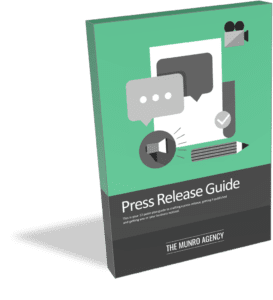

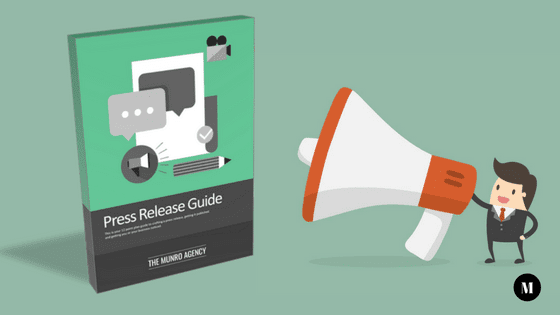
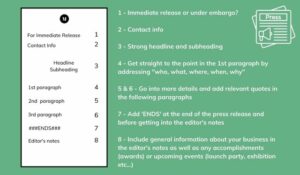
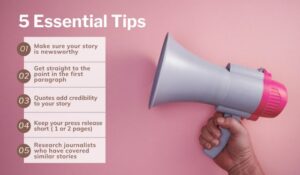
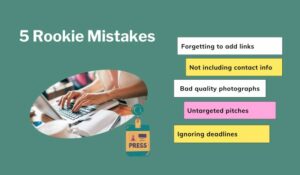








Leave a Comment